Embellishing fabric with beaded appliqué is a captivating craft that infuses elegance and intricate detailing into garments, accessories, and decor.
This artful technique involves securing ornate beadwork onto a fabric base, creating a stunning fusion of texture and shimmer.
Whether you’re a seasoned artisan or a novice enthusiast, mastering the art of attaching beaded appliqué requires precision and a thoughtful approach.
From selecting suitable materials to employing various attachment methods, this guide will walk you through the steps, ensuring your creations showcase the allure and craftsmanship of beaded embellishments.
Discover the secrets to achieving professional-grade results and breathe life into your textile projects with this step-by-step exploration.
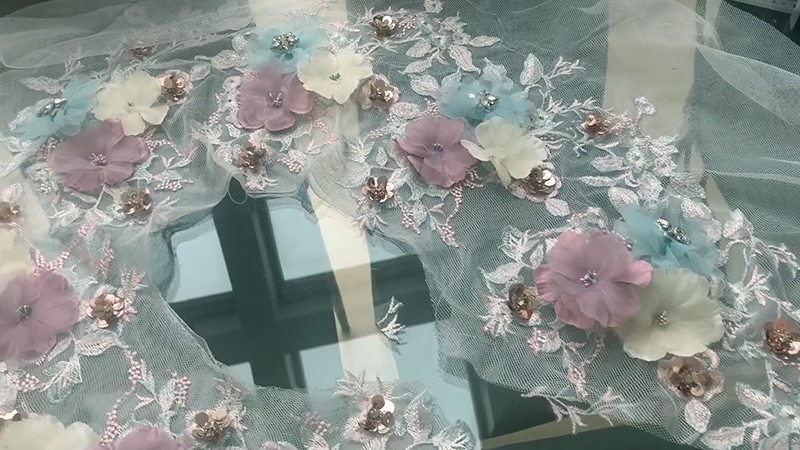
What Is Beaded Applique?
A beaded appliqué is an ornamental embellishment made by stitching beads, sequins, or other decorative elements onto a base fabric. Typically, the base fabric is a mesh or felt-like material, which provides a stable surface for the intricate beadwork.
Beaded appliqués come in various shapes, sizes, and designs, ranging from delicate floral patterns to intricate geometric motifs. They are widely used in fashion and crafts to add texture, dimension, and glamour to clothing, accessories, and home décor items.
These exquisite pieces showcase the artistry and craftsmanship of beadwork, often serving as focal points that elevate the visual appeal of the item they adorn, making them popular choices for customizing and enhancing a wide range of projects.
How to Attach Beaded Applique to Fabric? 10 Steps
Attaching beaded appliqué to fabric is a creative and visually stunning way to embellish clothing, accessories, or home decor items.
Beaded appliqués come in various designs, sizes, and materials, making them versatile for adding elegance and charm to your projects.
Whether you’re a seasoned crafter or a beginner, here’s a step-by-step guide on attaching beaded appliqué to fabric.
Materials You’ll Need:
- Beaded Appliqué.
- Fabric.
- Needle.
- Thread.
- Pins.
- Scissors.
- Thimble.
Step-by-Step Guide:
Step 1: Prepare Your Workspace
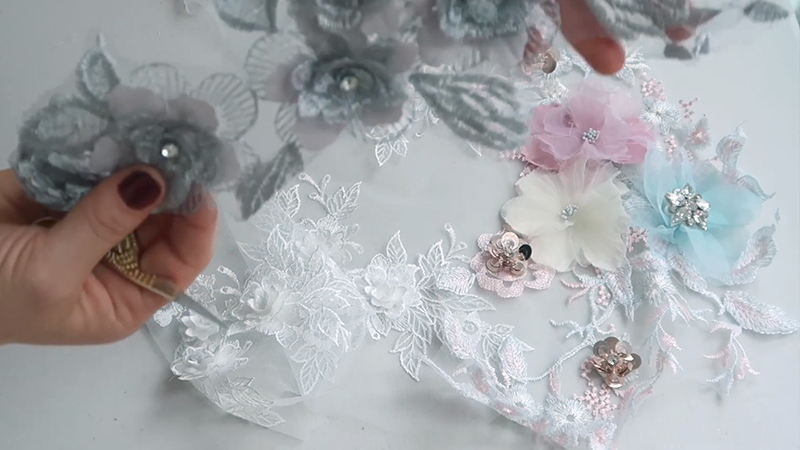
Clear, comfortable, spacious area with good lighting for your project. A clean, clutter-free surface prevents snags or disruptions while attaching the appliqué.
Make sure your fabric is smoothed out and free from any wrinkles. If necessary, press it with an iron on a low heat setting.
Step 2: Position the Appliqué
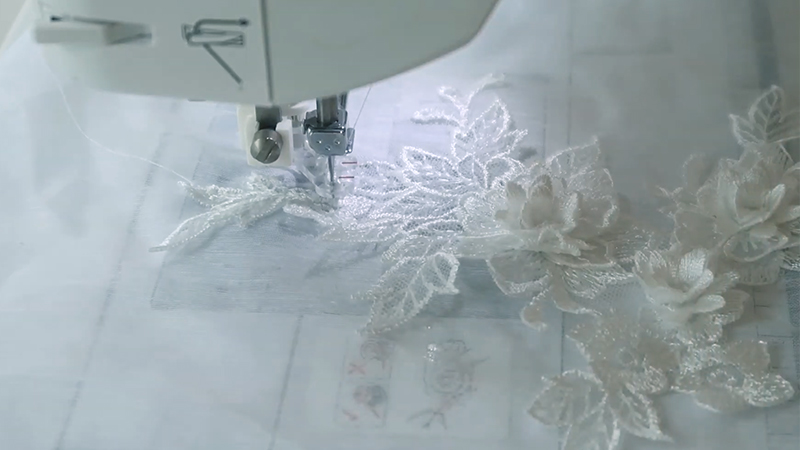
Take your time to position the beaded appliqué on the fabric carefully. Consider factors like the garment’s shape, design, and the overall aesthetic you’re aiming for.
Adjust the placement until you’re satisfied with how it looks. Use a ruler or measuring tape for precise positioning if needed.
Once confident in the placement, use pins to secure the appliqué temporarily. Ensure they’re placed strategically so they don’t obstruct your sewing path.
Step 3: Thread Your Needle
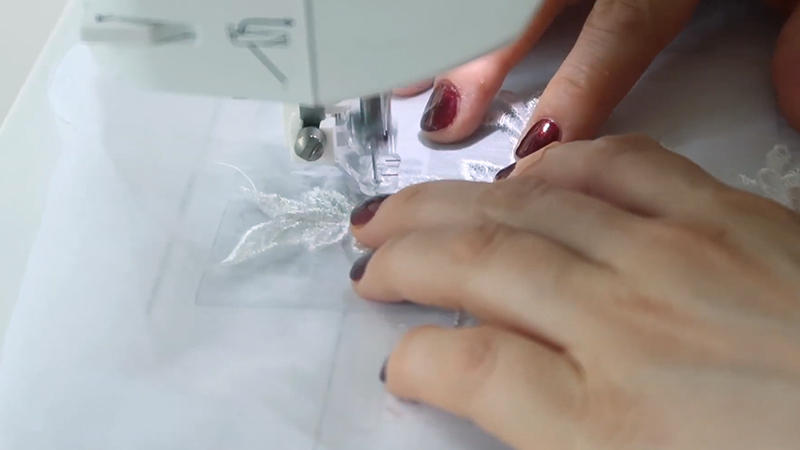
When threading the needle, ensure the thread end is smooth and won’t fray easily. If working with a thicker thread, you may want to use a needle threader for added ease.
Ensure your knot is secure by double or triple-looping the thread before pulling it through. This will prevent the thread from slipping out during sewing.
Step 4: Start Sewing
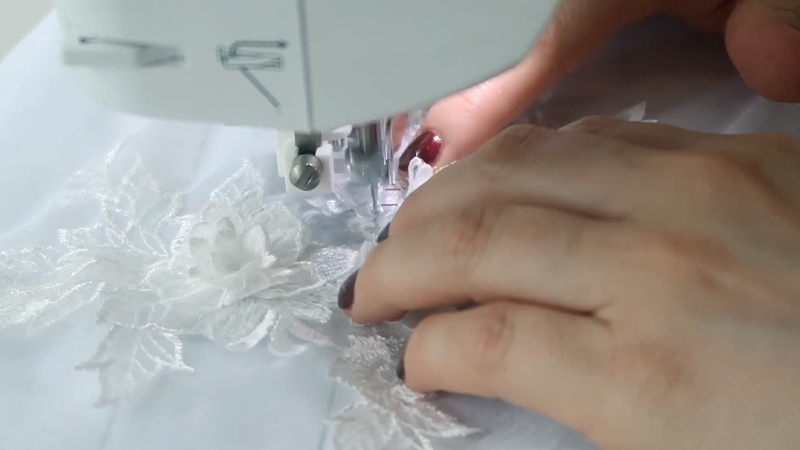
Begin sewing from the backside of the fabric, ensuring that the knot is anchored and won’t pull through. This initial stitch is crucial for stability.
Position the needle close to the appliqué’s edge and gently pull it through. Don’t pull too tight, as it could pucker the fabric.
Step 5: Secure the Appliqué
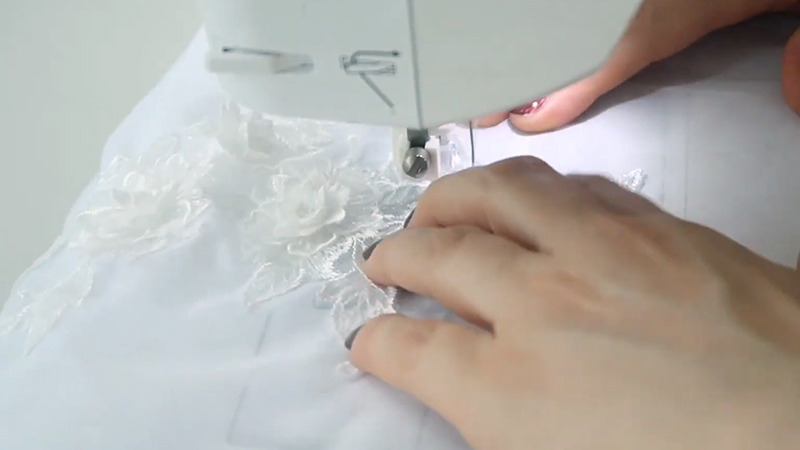
As you pass the needle through the edge of the appliqué, aim to catch a few beads or sequins in each stitch.
This ensures a secure attachment. Be mindful of the tension on the thread; it should be taut but not so tight that it distorts the fabric or appliqué. Keep your stitches small and evenly spaced for a professional finish.
Step 6: Continue Stitching
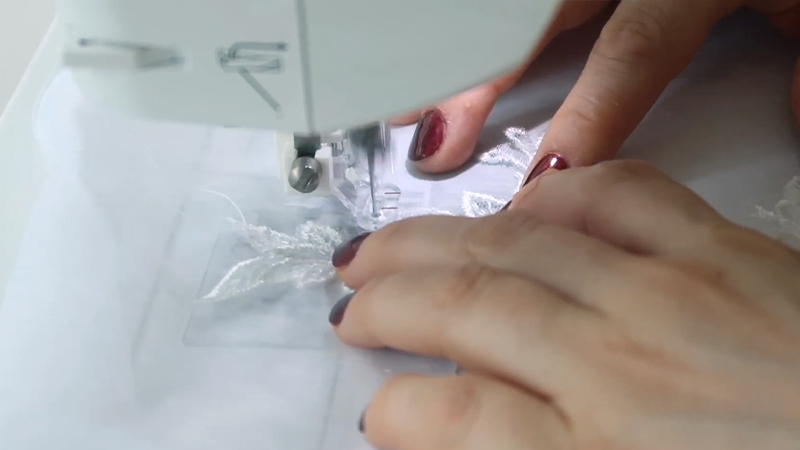
Maintain a consistent rhythm as you work your way around the edge. Please pay attention to the placement of your stitches, ensuring they’re discreet and blend seamlessly with the design.
If you encounter areas with denser beading or sequins, adjust your stitch length accordingly to maintain an even attachment.
Step 7: Finishing
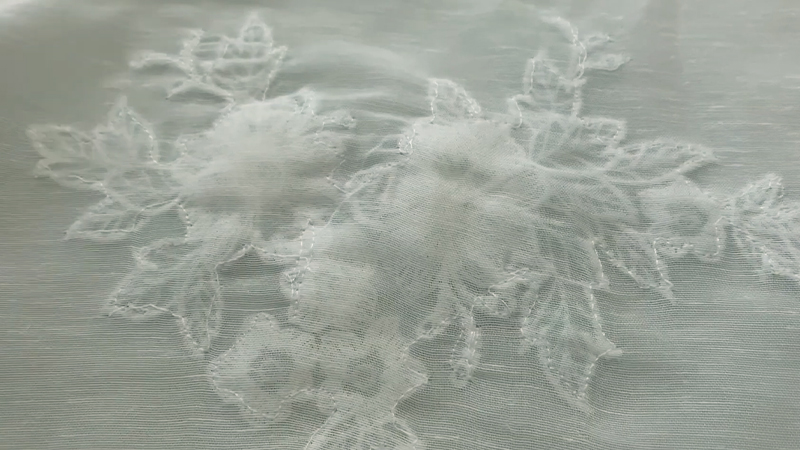
Once you’ve circled the entire edge, reinforce your work by passing the needle to the backside of the fabric. Tie a secure knot, ensuring it’s snug against the fabric but not too tight.
Trim any excess thread with sharp scissors, leaving a clean and neat finish. Ensure the appliqué is firmly attached by gently testing its stability.
Step 8: Additional Embellishments
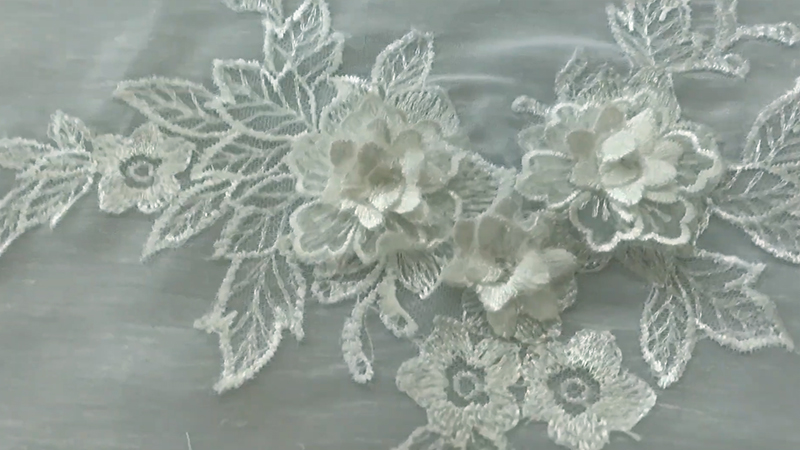
Exercise caution and precision if you add extra beads or sequins. Ensure they complement the existing design and are evenly distributed. Use the same stitching technique, taking care not to disrupt the flow of the overall pattern.
Step 9: Final Touches
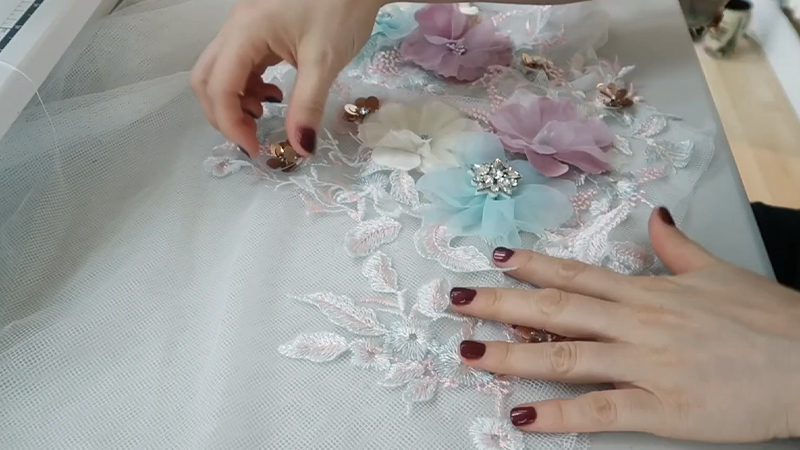
Conduct a thorough examination of your work, paying close attention to all edges. Check for any loose threads or areas that might benefit from additional reinforcement.
Make any necessary adjustments to guarantee a flawless, professional appearance.
Step 10: Care Instructions
Familiarize yourself with the specific care requirements for the fabric and the appliqué. Some beaded appliqués may necessitate special handling, such as spot cleaning or gentle handwashing.
Following proper care guidelines will help preserve the longevity and beauty of your finished project.
Alternative Methods to Attach Beaded Applique to Fabric
There are a few alternative methods to attach beaded appliqué to fabric. Each technique offers a unique approach, allowing you to choose the one that best suits your project and preferences.
Here are the alternative methods to attach beaded appliqué to fabric:
Fabric Glue Method
Using a hot glue gun or fabric glue is quick and straightforward. Apply a thin, even layer of glue to the back of the beaded appliqué. Press it firmly onto the fabric in your desired location.
Hold it for a few seconds to allow the glue to set. Be cautious not to use too much glue, as it can seep through the fabric and be visible.
Fusible Web Method
Fusible web or interfacing is a versatile option for attaching appliqué. Cut a piece to match the size of the appliqué.
Place it between the appliqué and fabric, ensuring the adhesive side faces the fabric. Use a hot iron to press the layers together, following the manufacturer’s instructions for temperature and duration.
This method creates a durable bond, but choose a web that won’t damage the beads or sequins.
Double-Sided Tape Method
Double-sided fabric tape offers a temporary attachment solution suitable for lightweight appliqués. Apply the tape to the back of the appliqué, making sure to use a tape designed for fabric.
Press the appliqué onto the fabric, applying gentle pressure to secure it in place. Keep in mind that this method may not provide a long-lasting hold.
Bonding Web Method
Like the fusible web, Stitch-Witchery or bonding web provides a solid and durable bond. Cut a piece of bonding web to match the size of the appliqué. Place it between the appliqué and fabric, with the paper backing facing up.
Use a hot iron to press the layers together, following the manufacturer’s instructions. W carefully peel off the paper backing once the adhesive has melted and bonded.
Machine Stitching Method
If the appliqué is relatively flat and doesn’t have a heavy backing, a sewing machine with a narrow zigzag stitch can be used.
Position the appliqué on the fabric and carefully guide it through the machine, ensuring that the needle catches the edge of the appliqué. This method provides a secure attachment for flat appliqués.
Ironing Method
Position a clean cloth over the beaded appliqué. Set the iron to a low heat setting and gently press it over the fabric, avoiding direct contact with the beads.
This method helps activate any heat-sensitive adhesive, securely attaching the appliqué to the fabric. Ensure the beads don’t melt or warp.
What Kind of Beads and Thread Should You Use for Beaded Applique?
The choice of beads and thread for beaded appliqué depends on your project’s desired look, feel, and durability.
Here are some considerations:
Beads:
Seed Beads
These tiny beads, available in a spectrum of sizes, are a staple in beadwork. They’re ideal for intricate designs, providing a smooth, consistent texture. Brands like Miyuki and Toho offer high-quality seed beads, ensuring uniformity in size and shape.
Bugle Beads
Long, tube-shaped, and bugle beads can add a dynamic element to your appliqué. They’re particularly effective in creating lines, borders, or accents, offering a unique visual appeal.
Sewn-on Sequins
Flat sequins designed for sewing are famous for adding sparkle and texture to beaded appliqué. They come in various shapes – circular, square, or even specialty designs – providing a diverse range of embellishment options.
Faceted Beads
These beads have multiple flat surfaces that catch and reflect light, adding a captivating sparkle to your appliqué. They work exceptionally well when you want to create a dazzling effect.
Specialty Beads
Depending on your design, consider using specialty beads like bugle fringe for a decorative edge or larger accent beads for a focal point. These unique beads can bring an extra layer of visual interest to your appliqué.
Thread
Nymo Thread
This nylon thread is a favored choice for beadwork due to its strength and delicate texture.
It comes in sizes (B, D, and O) to accommodate different bead sizes and project requirements. Nymo thread provides durability, ensuring your beadwork remains securely attached.
Fireline
A braided thread known for its strength and nearly invisible appearance, Fireline is an excellent choice when you want to focus primarily on the beads.
It’s beneficial for transparent or translucent beads, as it won’t detract from their natural beauty.
Monofilament Thread
This clear or smoke-colored nylon thread offers the advantage of being nearly invisible, making it a go-to option for projects where you want the beads to stand out without the distraction of visible thread. It’s an excellent choice for delicate or intricate designs.
Silamide
This twisted nylon thread is renowned for its strength and resilience. It’s particularly well-suited for bead embroidery projects where you need a durable thread that can withstand the tension and stress of intricate stitching.
Silk Thread
If you’re aiming for a traditional or vintage aesthetic, silk thread is an excellent choice. Its natural fibers provide a delicate, refined look. It’s perfect for projects that evoke a sense of timeless elegance.
Tips and Care For Beaded Applique Fabric
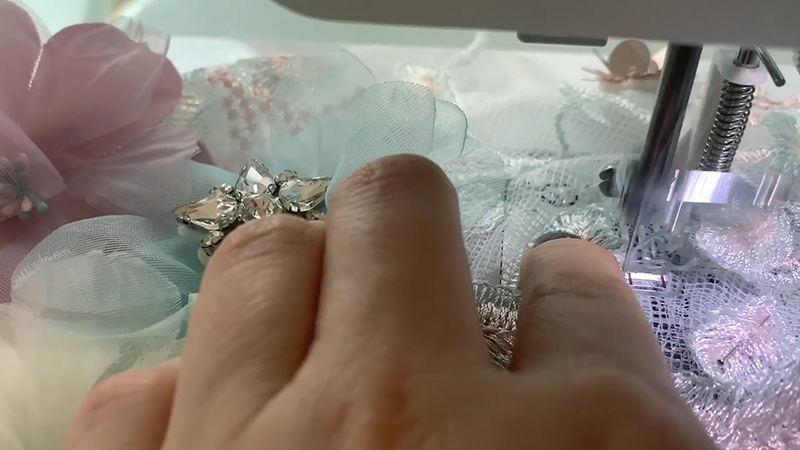
Beaded appliqué fabric adds a touch of elegance and sparkle to your projects, but it also requires special care to maintain its beauty and longevity.
Here are some tips and care guidelines for beaded appliqué fabric:
Handle with Care
When handling beaded appliqué fabric, use clean, dry hands to avoid transferring dirt or oils onto the delicate beads. Avoid sharp objects or rough surfaces that snag or damage the beads or threads.
Washing
Use mild detergent and cold water when the care label permits handwashing. Gently agitate the fabric to clean it without causing undue stress on the beads. Rinse thoroughly and avoid excessive wringing.
For dry-clean only fabrics, entrust them to a professional cleaner experienced in handling delicate beadwork.
Drying
After washing, gently blot excess water from the fabric with a clean towel. Avoid wringing or twisting, which can strain the beads and threads.
Lay the fabric flat on a clean towel to air dry. Ensure it’s on a level surface and that the beads are evenly distributed to prevent distortions.
Storage
Store beaded appliqué fabric in a relaxed, dry environment away from direct sunlight. Prolonged exposure to sunlight can cause the colors to fade over time.
When folding is necessary, use acid-free tissue paper to cushion and prevent creasing. Store the fabric in a breathable fabric bag or pillowcase.
Ironing
When ironing beaded appliqué fabric, turn it inside out if possible. This allows you to iron the reverse side, which is generally less delicate.
Use a low heat setting on the iron, or cover the fabric with a clean pressing cloth to shield the beads from direct heat.
Repairs
Regularly inspect the fabric for loose or missing beads. Promptly repair any damage using matching beads and a fine, strong thread. Secure the replacement bead with tight, even stitches.
Wear with Caution
Be mindful of the activities you engage in while wearing beaded appliqué garments. Avoid situations where the fabric could be subjected to excessive wear, rubbing, or snagging.
Avoid Contact with Moisture
Moisture can weaken the threads and cause beads to discolor or become loose. Avoid wearing beaded appliqué in rainy or humid conditions, and keep it dry.
Traveling
When packing beaded appliqué garments for travel, use padded hangers or garment bags to protect them from wrinkles, crushing, or other potential damage during transit.
Testing
When you’re uncertain about how to care for a specific beaded appliqué fabric, test a small, inconspicuous area first. This allows you to evaluate the cleaning or care method without risking damage to the entire piece.
FAQs
What type of thread is best for attaching beaded appliqué?
Use a robust and fine thread like Nymo or Fireline. These threads are durable and provide a secure attachment for the beads.
Can I use a sewing machine to attach beaded appliqué?
It’s possible, but for delicate beadwork, hand sewing is recommended. A sewing machine may not handle the intricacies of attaching beads.
How do I prevent the beads from scratching or damaging the fabric?
Place a clean cloth or pressing cloth over the beaded area when ironing. This will protect the beads and prevent them from scratching the fabric.
What’s the best way to secure loose or missing beads on an appliqué?
Thread a needle with matching thread and carefully stitch the replacement bead into place. Ensure it’s tightly secured to prevent further loosening.
Can I wash the fabric with the beaded appliqué attached?
It depends on the fabric and the type of beads used. Always check the care instructions for both the fabric and the appliqué. In some cases, dry cleaning may be the safest option.
Wrap Up
Incorporating beaded appliqué into fabric projects offers a unique opportunity to blend creativity with craftsmanship.
You can bring breathtaking designs that captivate the eye by carefully selecting materials and methodical attachment techniques. Remember, practice and patience are vital companions on this artistic journey.
As you hone your skills, you’ll find yourself pushing the boundaries of what can be achieved with beads and fabric. Whether adorning garments, accessories, or decor, each piece becomes a testament to your dedication and artistry.
Embrace the process, and let your creations shine with the timeless beauty of beaded appliqué, leaving a lasting impression on admirers and inspiring future projects.
Leave a Reply